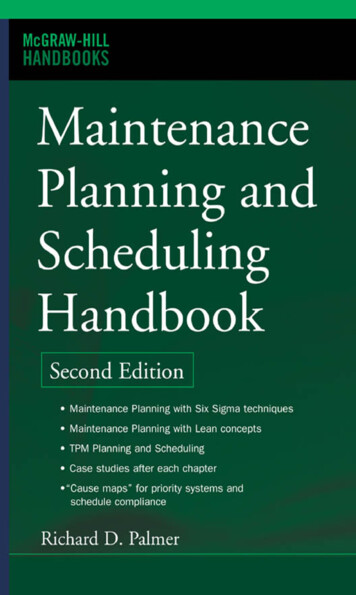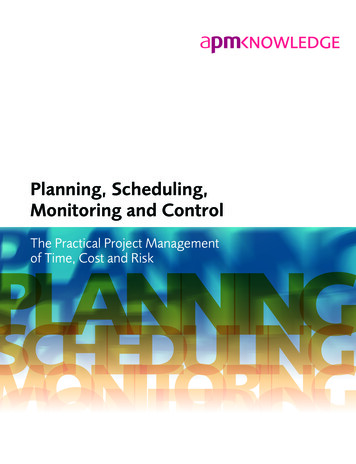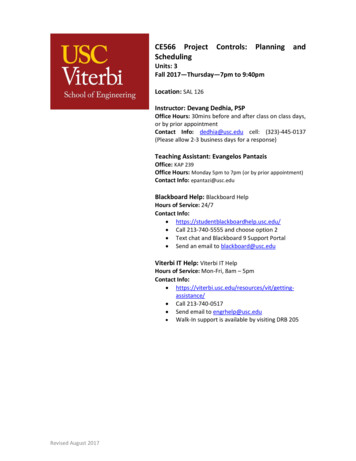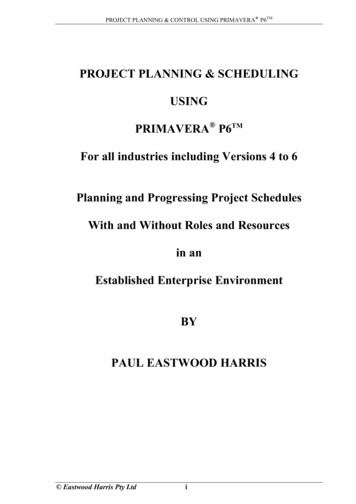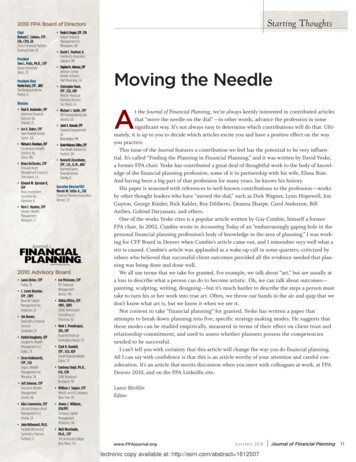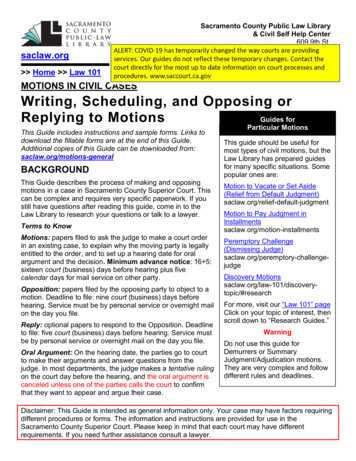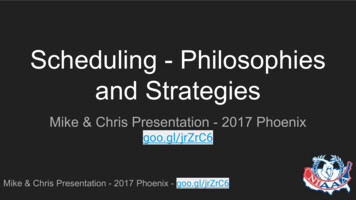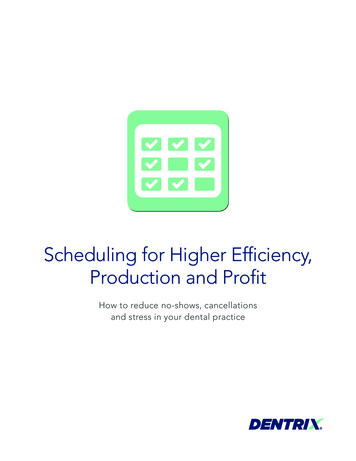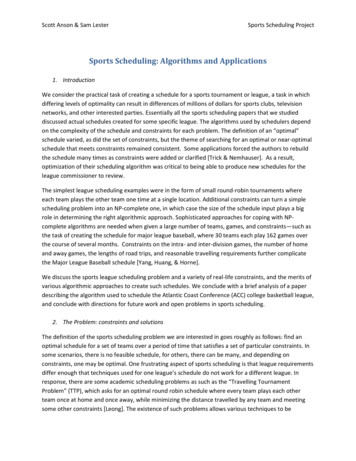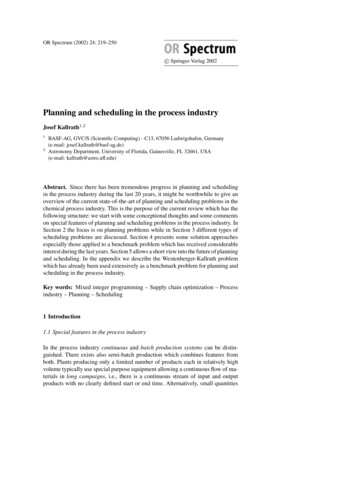
Transcription
OR Spectrum (2002) 24: 219–250c Springer-Verlag 2002 Planning and scheduling in the process industryJosef Kallrath1,212BASF-AG, GVC/S (Scientific Computing) - C13, 67056 Ludwigshafen, Germany(e-mail: josef.kallrath@basf-ag.de)Astronomy Department, University of Florida, Gainesville, FL 32661, USA(e-mail: kallrath@astro.ufl.edu)Abstract. Since there has been tremendous progress in planning and schedulingin the process industry during the last 20 years, it might be worthwhile to give anoverview of the current state-of-the-art of planning and scheduling problems in thechemical process industry. This is the purpose of the current review which has thefollowing structure: we start with some conceptional thoughts and some commentson special features of planning and scheduling problems in the process industry. InSection 2 the focus is on planning problems while in Section 3 different types ofscheduling problems are discussed. Section 4 presents some solution approachesespecially those applied to a benchmark problem which has received considerableinterest during the last years. Section 5 allows a short view into the future of planningand scheduling. In the appendix we describe the Westenberger-Kallrath problemwhich has already been used extensively as a benchmark problem for planning andscheduling in the process industry.Key words: Mixed integer programming – Supply chain optimization – Processindustry – Planning – Scheduling1 Introduction1.1 Special features in the process industryIn the process industry continuous and batch production systems can be distinguished. There exists also semi-batch production which combines features fromboth. Plants producing only a limited number of products each in relatively highvolume typically use special purpose equipment allowing a continuous flow of materials in long campaigns, i.e., there is a continuous stream of input and outputproducts with no clearly defined start or end time. Alternatively, small quantities
220J. Kallrathof a large number of products are preferably produced using multi-purpose equipment which are operated in batch mode, i.e., there is a well-defined start-up, e.g.,filling in some products, well-defined follow-up steps defined by specific recipes,e.g., heating the product, adding other products and let them react, and a clearly defined end, e.g., extracting the finished product. Batch production involves an integernumber of batches where a batch is the smallest quantity to be produced, e.g., 500kg. Several batches of the same product following each other immediately establish a campaign. Production may be subject to certain constraints, e.g., campaignsare built up by a discrete number of batches, or a minimal campaign length (orproduction quantity) has to be observed. Within a fixed planning horizon, a certainproduct can be produced in several campaigns; this implies that campaigns have tobe modelled as individual entities.Another special feature in the refinery or petrochemical industry or processindustry in general is the pooling problem (see, for instance, [28], or Chapter 11 in[42]), an almost classical problem in nonlinear optimization. It is also known as thefuel mixture problem in the refinery industry but it also occurs in blending problemsin the food industry. The pooling problem refers to the intrinsic nonlinear problemof forcing the same (unknown) fractional composition of multi-component streamsemerging from a pool, e.g., a tank or a splitter in a mass flow network. Structurally,this problem contains indefinite bilinear terms (products of variables) appearing inequality constraints, e.g., mass balances. The pooling problem occurs in all multicomponent network flow problems in which the conservation of both mass flow andcomposition is required and both the flow and composition quantities are variable.Non-linear programming (NLP) models have been used by the refining, chemical and other process industries for many years. These nonlinear problems are nonconvex and either approximated by linear ones and solved by linear programming(LP) or approximated by a sequence of linear models. This sequential linear programming (SLP) technique is well established in the refinery industry but suffersfrom the drawback of yielding only locally optimum solutions. Although manyusers may identify obviously sub-optimal solutions from experience, there is novalidation of those which are not obviously so, as this would require truly globally optimal solutions. From an end-user point of view, the problems of existingtechnology are becoming ever more acute. Since the market for products such asgasoline and chemicals are becoming increasingly amalgamated, many planningproblems now necessarily involve multiple production facilities in geographicallyseparate sites, with concomitant interactions and interconnections. These are hardto solve and much more prone to giving sub-optimal local solutions, particularlyif they stretch over many time periods. However, recent advances in optimizationalgorithms have yielded experimental academic codes which do find truly globallyoptimal solutions to these NLP models. Non-convex nonlinear models are not restricted to the oil refining and petrochemical sector, but arise in logistics, networkdesign, energy, environment, and waste management as well as finance and theirsolution asks for global optimization.In the chemical process industry, the proper description of the reaction kineticsleads to exponential terms. If, in addition, plants operate in discrete modes orconnections between various units, e.g., tanks and crackers or vacuum columns
Planning and scheduling in the process industry221have to be chosen selectively, then mixed-integer nonlinear optimization problemsneed to be solved. Process network flow or process synthesis problems [30] usuallyfall into this category, too. Examples are heat exchanger or mass exchange networks.Planning and scheduling is part of company-wide logistics and supply chainmanagement. However, to distinguish between those topics, or even to distinguishbetween planning and scheduling is often a rather artificial approach. In reality, theborder lines between all those areas are diffuse. There are strong overlaps betweenscheduling and planning in production, distribution or supply chain managementand strategic planning.1.2 Some comments on planning and scheduling in the process industryAlthough the boundary between planning and scheduling is diffuse let us try towork out a few structural elements of planning and scheduling, which may includethe following features: multi-purpose (multi-product, multi-mode) reactors,sequence-dependent set-up times and cleaning cost,combined divergent, convergent and cyclic material flows,non-preemptive processes (no-interruption), buffer times,multi-stage, batch & campaign production using shared intermediates,multi-component flow and nonlinear blending,finite intermediate storage, dedicated and variable tanks.Structurally, these features often lead to allocation and sequencing problems, knapsack structures, or to the pooling problem. As there is no clear definition of the borderline between planning and scheduling problems, we try to illuminate the subjectfrom different angles by summarizing a few aspects and objectives of planning andscheduling and try to develop a kind of an informal definition serving as a platform.In production or supply chain planning, we usually consider material flow and balance equations connecting sources and sinks of a supply network. Time-indexedmodels using a relative coarse discretization of time, e.g., a year, quarters, monthsor weeks are usually accurate enough. LP, MILP and MINLP technologies are oftenappropriate and successful for problems with a clear quantitative objective functionas outlined in Section 2, or quantitative multi-criteria objectives.In scheduling problems the focus on time is more detailed and may require evencontinuous time formulations. Furthermore, one faces rather (conflicting) goals thanobjectives: the optimal use of resources, minimal makespan, minimal operatingcost or maximum profit versus more qualitative goals such as reliability (meetdemand in time, proper quality, etc.) and robustness; such qualitative goals areoften hard to quantify. The short-term operational aspects of operating a set ofchemical reactors, food producing machines or distillation columns in a refineryare of primary interest. Users are mostly interested in feasible, acceptable androbust schedules, the objectives are usually somewhat vague, but it is common thatthe possibility to interact and to re-schedule, as well as the stability of solutionsin cases of re-scheduling are highly appreciated. Scheduling problems are usuallyNP-hard, no standard solution techniques are available and, actually, in many cases
222J. Kallrathwe are facing feasibility problems rather than optimization problems. The solutionapproaches found in the literature are:– exact and deterministic methods such as mathematical optimization includingMILP and MINLP, graph theory (GT) or constraint programming (CP), orhybrid approaches in which MILP and CP are integrated,– meta-heuristics (evolutionary strategies, tabu search, simulated annealing, .)as described briefly in Section 4.2.4 or [48].In addition to these remarks it is worthwhile to comment on the difference betweenoffline and online scheduling [64]. Offline scheduling as mostly discussed in thisarticle, in the ideal case, assumes that all data of a problem are given, i.e., fullknowledge of the future (of course, this is also an approximation since our knowledge of future demand or orders is uncertain), and is close to planning except forthe length of the time horizon and the resolution of time. Online scheduling as aspecial case of (combinatorial) on-line optimization [11] makes decisions basedon past events and current data without information about future events relevantfor the current decision problem; many decisions have to be made before all dataare available and decisions once made cannot be changed. It may involve currentprocess control data, updated demand data and orders, but misses orders which mayenter the system in the near future and within the horizon of the current schedule tobe determined. The goal is to exploit uncertain (w.r.t. the future) and incomplete information in such a way to improve the final quality of its overall performance, i.e.,the quality of schedules over rolling time horizons. Unlike in stochastic optimization, where known data are subject to stochastistic uncertainties, the uncertainty inon-line scheduling only arises from the uncertainty of future data.2 Model features in planning problemsPlanning in the process industry is used to create production, distribution, salesand inventory plans based on customer and market information while observing allrelevant constraints. In particular, operational plans have to be determined whichare aimed to structure future production, distribution and other related activitiesaccording to business objectives. It is common practice that, based on these operational plans, detailed schedules are worked out which define the precise timingand sequencing of individual operations as well as the assignment of the requiredresources over time. Planning tools and software packages from various vendors aredesigned to incorporate new market and operational information quickly and helpbusiness users to keep their operations performing at their optimum. Especially,nowadays it is possible to find the optimal way to meet business objectives and tofulfill all production, logistics, marketing, financial and customer constraints andespecially– to accurately model single site and multi-site networks;– to perform capital planning and acquisition or divestiture analysis, i.e., to havethe possibility to change the structure of a manufacturing production networkthrough investment and to determine the best investment type, size and location
Planning and scheduling in the process industry223based on user defined rules relating to business objectives and available resources, e.g., Kallrath [40]; the results of such analysis can lead to non-intuitivesolutions that provide management with scenarios that could dramatically increase profits;– to produce integrated enterprise solutions and to enable a cross-functional viewof the planning process involving production, distribution and transport, sales,marketing and finance functions.Planning as part of the supply chain management may focus on short and mid-termsales and operations planning or long-term acquisition, consolidation, and capacityanalysis with a strategic focus. In the literature and in available software packageswe usually find time-indexed models supporting multi-period analysis, i.e., nearlyall the data may vary over time and allow to evaluate scenarios that involve timedependent aspects such as seasonal demand patterns, new product introductions,shutdown of production facilities for maintenance periods. These models includethe following main structural objects:– Locations can be production or storage sites, hosting plants and tanks, or demand points hosting tanks.– Facilities typical are production, wrapping or inventory units that are characterized by their functional properties. Especially, in the process industry we findmulti-stage production systems involving units with general product-mode relationships. Their functional properties are attributes such as capacity, throughputrates, product recipes, yields, minimum production utilization rates, fixed andvariable costs, or storage limitations. Facilities can be existing or potential (fordesign studies). Production facilities may be subject to batch and campaignconstraints across periods.– Demand Points may represent customers, regional warehouse locations ordistributors who specify the quantity of a product they request. A demand pointcan be also seen as a sink of the planning model, i.e., a point where a productleaves t
Planning as part of the supply chain management may focus on short and mid-term salesandoperationsplanning orlong-term acquisition,consolidation,andcapacity analysis with a strategic focus. In the literature and in available software packages we usually find time-indexed models supporting multi-period analysis,i.e.,nearly
